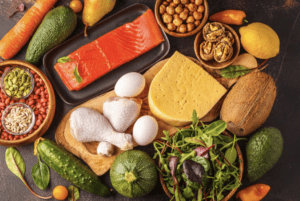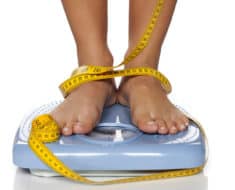
Source: shuttershock
A novel approach to losing weight, the keto diet is based on the consumption of a low quantity of carbs, with a moderate quantity of protein and a higher one of fats. Once the body is no longer provided with carbs (glucose) as main fuel, it will turn fat into ketones and use these as energy. In consequence, one will begin to lose weight and return to a healthy figure.
It is considered that this high-fat diet will help you burn fat in a more effective manner. As one adapts to the low-carb intake and the body begins to use ketone bodies, weight loss occurs naturally, with no sensation of hunger. In fact, this diet has even been proposed as a solution to reverse type 2 diabetes.
The ketone bodies are produced only when one eats a reduced quantity of carbs, with the liver using fat for such purposes. This is connected to the low levels of insulin, which is also beneficial for those suffering from diabetes. The body produces ketones when it reaches the state of ketosis (metabolic state characterized by intense fat burning).
Keto diet types
You might not be aware of this for a fact but there are different types of keto diet.
Standard Ketogenic diet:-There is the standard version, in which the diet should contain 75% fat, followed by 15-20% protein and 5-10% carbs. Recommended fat sources include olive oil, avocado, butter, fatty fish and olives. Basically, one should consume about 150 g of fat in a day. Reducing the carb intake might mean consuming veggies that are less starchy, as well as fruits such as berries. Proteins should not be consumed more than 90 grams per day.
Targeted Ketogenic diet:– In the targeted keto diet, you are allowed to consume 65-70% fat, 20% protein and 10-15% carbs.[1] This is a version recommended for athletes and those who prefer a more active lifestyle, with a higher content of carbs. One is allowed to consume approximately 80 grams of carbs per day. These will be burned through physical exercise.
Cyclical Ketogenic diet:- The cyclical keto diet allows one to consume 75% fat, 15-20% protein and 5-10% carbs when there are keto days. On off days, the macronutrient ratio includes 25% fat, 25% protein and 50% carbs. In this version, you have five days of keto and two days in which you maintain a more balanced diet. You are allowed to eat foods rich in carbs in these two days, such as veggies, dairy, and fruits.
High-protein keto diet – The high-protein keto diet brings down the fat percentage to 60-65%, with 30% protein and 5-10% carbs. One is allowed to eat approximately 130 grams of fat and an almost equal quantity of proteins. The carb intake will remain low. This is a version which many people find it easy to follow, given the higher protein intake. Even though it might contribute to weight loss, it will not be as effective as the standard version.
Best keto diet for weight loss
The standard keto diet remains the most effective when it comes to losing weight. It requires the consumption of high quantities of fat, with a moderate intake of proteins and a low carb percentage. This allows the body to enter a state of ketosis, with ketone bodies being used for energy and the fat burning process activated.
The important thing is that one consumes the required quantity of fat per day – about 150 grams – so that the metabolism can shift to ketosis and burn fat as fuel.
Attention should be paid to the carb intake, with a maximum quantity of 50 grams per day. This might be difficult at first, but once you will notice the results, you will definitely find the strength to persevere.
One might also consider some of the best ketogenic diet supplements, such as MCT oil, salt, and other minerals, caffeine, exogenous ketones, creatine, and whey. These can provide one with enhanced energy and contribute to the weight loss process.
Benefits of the ketogenic diet
One of the major benefits of the keto diet is that it curbs the hunger sensation, which is one of the main complaints when it comes to dieting. This is related to the reduced carb intake, allowing one to eat fewer calories.
As you will cut carbs, you will notice a significant weight loss to occur initially. This is because your insulin levels will be lowered and excess water removed from the body, contributing to rapid weight loss.
The keto diet promotes fat burning, and especially the one in the abdominal area (visceral fat included). Insulin resistance is often connected to the presence of excess visceral fat, increasing the risk of diabetes. This is one of the reasons for which this diet is recommended in those who suffer from type 2 diabetes.
The reduced carb consumption will cause your triglycerides to go down, while the consumption of more fat will increase the level of good cholesterol. The keto diet equals a reduced blood sugar and insulin level, it can lower blood pressure and fight against the metabolic syndrome.
Keto diet meal plan to follow daily
Each day of the week, you can opt for foods that are beneficial for your dietary needs and suited to the keto diet. You can follow these weekly steps to help you develop a keto diet plan for better results.
Breakfast:- Choices include fried eggs in pastured butter, served with sautéed greens; mushroom omelet; stuffed bell peppers with cheese and eggs; full-fat yoghurt and granola; avocado and eggs; cauliflower toast with avocado and cheese; chia pudding with walnuts and coconut.
Lunch:- You can choose between burgers (no bun), tuna salad with fresh veggies, arugula salad, steak, cauliflower, chicken, salmon, Cobb salad, greens, eggs etc.
Dinner:- It can include chicken curry, meatballs, pork chops, broccoli, spinach, salmon, chicken, green beans.
As for snacks, you might consider: cheese, almonds, guacamole, trail mix, eggs, avocado, coconut chips, kale chips, olives, celery, bell peppers, berries, beef jerky, macadamia nuts, smoothies (coconut milk) or chocolate whey protein powder.
Foods to eat and foods to avoid
Foods allowed: Fish (salmon, mackerel, sardines) and shellfish (clams, mussels, octopus, oysters, squid); low-carb veggies (cauliflower, zucchini, squash); cheese, Greek yoghurt, cottage cheese; avocado; meat and poultry (grass-fed); eggs; coconut oil; olive oil; nuts and seeds.
Foods to avoid: Potatoes, carb-rich fruits (bananas), sodas, fruit juices, pasta, white rice, bread, chocolate bars, beer, donuts, candy, corn, beans, sweets, beer, oatmeal; root vegetables, grains; legumes, sweeteners; oils (canola, soybean, sesame, sunflower); alcohol; low-fat dairy; sauces and dips (with sugar).
Side-effects of the keto diet
Even though there are no actual side effects of the keto diet, you might notice some changes upon entering the state of ketosis. These include: a bad breath (elevated ketone levels), rapid weight loss (in the initial period), increased ketones in the blood (reduction of blood sugar) and fatigue (short term).
You might also complain of digestive issues, such as constipation or diarrhea, as your body becomes accustomed to the keto diet. Insomnia is another complaint, especially in those who are used to late night snacks rich in carbs. Keep in mind that your body is transitioning, so be patient.
FAQs
How long does it take to reduce weight with the keto diet?
This is probably one of the most frequently asked questions, as everyone wants to know how long it will be before they get back to a healthy figure. First and foremost, everyone is different, so the timeline for losing weight might vary as well.
It all depends on one’s health and metabolic status, as well as on the percentage of body fat, daily habits and adaptation period. It might take up to a week to reach ketosis and, in order to lose weight, one should stick to the recommended foods.
In the first week, the weight loss is pronounced. Afterwards, you might expect to lose about 1 kg per week. You can expect about 15 kg to be lost over the course of several months.
What is the protein intake when you are in ketosis?
The intake of proteins can play a serious role in the success of your keto diet. It is important to remember that protein can also be converted into glucose, causing your insulin levels to rise and affecting the ketosis process.
The intake of protein varies in accordance with how active you are. For example, if you lead a sedentary lifestyle, you should eat between 0.6 and 0.8 grams of protein per pound of lean body mass. A regularly active person should consume between 0.8 and 1 grams of protein, while weight lifters should eat between 1.0 and 1.2 grams.
Is the keto diet good during pregnancy?
The keto diet is not recommended at the moment for pregnant women. There are controversies regarding the effect of ketone bodies, present in high quantities, over the development of the fetus. More studies are required to confirm the effect of this dietary approach over both mother and baby.
Is alcohol allowed during the keto diet?
Even though, as a general rule, alcohol is forbidden during the keto diet, there are some keto-friendly beverages you might be allowed to consume. Carb-free beverages include vodka, gin, tequila, rum, and whiskey. Light beer and wine might be consumed in a reduced quantity. Cocktails should be avoided.
Bottom line
In conclusion, the ketogenic diet is an effective solution for those who are interested in losing weight. Combined with a regular fitness routine and proper supplements like Ketoburn Extreme can help one return to a healthy figure and look better than ever.
The essential thing is that one respects the rules of the diet, opting for meals that contain only allowed foods and verifying the macronutrient intake on a regular basis. The keto diet is not difficult to follow and it delivers noticeable results, being easy to pair with a workout routine.
Reference:-















